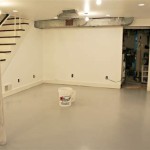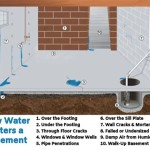Cleaning Up Sewage In Basement: A Comprehensive Guide
Dealing with sewage backup in your basement can be a daunting and overwhelming experience. Sewage contains harmful bacteria and contaminants that pose significant health risks. It's crucial to address this issue promptly and effectively to prevent further damage and ensure the safety of your household.
Here's a comprehensive guide to help you clean up sewage in your basement safely and effectively:
1. Safety Precautions
Before starting the cleanup, ensure your safety by taking the following precautions:
- Wear protective gear such as gloves, boots, a mask, and goggles.
- Open windows and doors for ventilation to reduce odor and harmful fumes.
- Avoid touching or coming into direct contact with sewage.
2. Identify the Source
To determine the source of the sewage backup, inspect your basement and identify any potential leaks or blockages in pipes, drains, or toilets.
3. Stop the Flow
Once the source is identified, stop the flow of sewage by:
- Turning off the main water supply valve.
- Unclogging drains or clearing any blockages in pipes.
- Calling a plumber for professional assistance if the leak is extensive.
4. Remove the Sewage
Use a wet/dry vacuum or a sump pump to remove the sewage from your basement. For larger amounts of sewage, you may need to rent a portable pump or call a sewage removal service.
5. Disinfect the Area
To kill bacteria and prevent contamination, disinfect the affected area using a bleach solution. Mix one cup of chlorine bleach per gallon of water and apply it thoroughly to all surfaces that came into contact with sewage.
6. Clean and Dry the Basement
Once the area is disinfected, thoroughly clean the basement with a strong cleaning solution and allow it to dry completely. Use fans or a dehumidifier to accelerate the drying process.
7. Remove Odors
Lingering odors can be a nuisance after a sewage cleanup. To eliminate them, use an air purifier or place bowls of baking soda or activated charcoal around the basement.
8. Restore the Basement
After the basement is clean and dry, restore it by making any necessary repairs to damaged walls, flooring, or fixtures. If the sewage backup caused significant damage, you may need to contact a contractor for professional restoration work.
9. Prevent Future Backups
To prevent future sewage backups, take these precautions:
- Regularly inspect and clean your plumbing system.
- Install a backflow prevention valve.
- Avoid flushing non-flushable items down toilets.
- Fix any leaks promptly.
Conclusion
Cleaning up sewage in a basement is a challenging task, but it's essential to do it safely and thoroughly to protect your health and property. By following the steps outlined in this guide, you can effectively address this issue and restore your basement to a clean and safe condition.

Critical Information About Cleaning Up A Basement Sewage Backup

Sewage Basement Backup Craftsman Home Remodeling

Fact Sheet Cleaning Up After Flood Sewer Backups Hamilton County Public Health

How To Handle A Sewage Backup In The Basement

Sewage Cleanup Smelly Challenging Profitable When Done Right 2024 01 04 Restoration Remediation Magazine

How To Clean Your Basement After A Sewer Backup

Basement Drain Backing Up Here S What To Do Right Now Servicemaster

Lexington Crawl Space Sewage Spill Servicemaster Fire Water Restoration Services

What To Do After Sewage Backup How Clean Up

Sewage Damage Cleanup And Removal Na Restoration Cleaning Services
See Also








